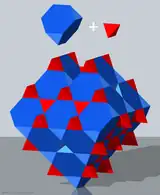| Triakis truncated tetrahedral honeycomb | |
|---|---|
 | |
| Cell type | Triakis truncated tetrahedron |
| Face types | hexagon isosceles triangle |
| Coxeter group | Ã3×2, [[3[4]]] (double) |
| Space group | Fd3m (227) |
| Properties | Cell-transitive |
The triakis truncated tetrahedral honeycomb is a space-filling tessellation (or honeycomb) in Euclidean 3-space made up of triakis truncated tetrahedra. It was discovered in 1914.[1][2]
Voronoi tessellation
It is the Voronoi tessellation of the carbon atoms in diamond,[3][4] which lie in the diamond cubic crystal structure.
Being composed entirely of triakis truncated tetrahedra, it is cell-transitive.
Relation to quarter cubic honeycomb
It can be seen as the uniform quarter cubic honeycomb where its tetrahedral cells are subdivided by the center point into 4 shorter tetrahedra, and each adjoined to the adjacent truncated tetrahedral cells.
See also
References
- ↑ Föppl, L. (1914). "Der Fundamentalbereich des Diamantgitters". Phys. Z. 15: 191–193.
- ↑ Grünbaum, B.; Shephard, G. C. (1980). "Tilings with Congruent Tiles". Bull. Amer. Math. Soc. 3 (3): 951–973. doi:10.1090/s0273-0979-1980-14827-2.
- ↑ Conway, John. "Voronoi Polyhedron". geometry.puzzles. Retrieved 20 September 2012.
- ↑ Conway, John H.; Burgiel, Heidi; Goodman-Strauss, Chaim (2008). The Symmetries of Things. p. 332. ISBN 978-1568812205.
This article is issued from Wikipedia. The text is licensed under Creative Commons - Attribution - Sharealike. Additional terms may apply for the media files.
